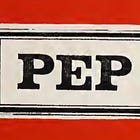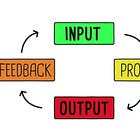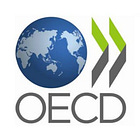The first three essays in this series traced the construction of a planetary operating system: how the Marshall Plan's visible bridges (economic coordination, legal integration, security containers) rested on hidden financial rails (the BIS, IMF, and World Bank), and how this European prototype scaled globally through development aid, technocratic management systems, and indicator-based governance.
But this essay marks a crucial turning point. Europe's operating system learned a new trick — it began to patch itself live. The system ceased to be a fixed machine implementing predetermined rules and became an adaptive, reflexive system capable of modifying its own parameters in real-time.
What happens when governance becomes recursive, when the operating system starts to rewrite its own code?
And how does Ukraine, Palantir and Trump’s ‘AI Stargate’ initiative fit into this?
Britain's Laboratory: Political and Economic Planning (1931)
To understand how the system became self-modifying, we must first examine its domestic prototype. Long before the Marshall Plan or Bretton Woods, Britain's Political and Economic Planning organisation1 (PEP), founded in 1931, functioned as the nation's laboratory for technocratic governance.
PEP pulled together an unusual coalition: Fabian socialists, professional economists, civil servants, and progressive businessmen, all united by the belief that complex industrial societies required expert management rather than purely political direction2. They pioneered techniques that would later become standard: white papers analysing policy performance, input-output models tracking economic flows, statistical forecasting, and sectoral dashboards monitoring everything from housing to healthcare.
Most significantly, PEP pioneered the use of permanent expert committees to monitor policy performance and recommend adjustments3 — the domestic prototype of what would become adaptive management. Rather than implementing fixed five-year plans, PEP developed methods for continuous policy review and refinement.
The organisation's influence was profound but indirect. PEP's 1937 ‘Report on the British Health Services’4 created the analytical template that would later inform the 1942 Beveridge Report's welfare state architecture5. During World War II, PEP's planning methods migrated into wartime ministries6, proving that expert-driven coordination could coexist with formal democratic institutions. After 1945, Labour's postwar planning apparatus drew directly on PEP's innovations7.
The personnel continuities were equally important. Many PEP figures overlapped with the Fabian-Apostolic-RIIA-Keynesian circles that would later design Bretton Woods and the UN system8. What appeared as separate national and international initiatives were actually components of a coordinated intellectual project testing the same planning logic at different scales.
The trajectory was clear: Britain (PEP) served as the national laboratory for expert planning, the Marshall Plan provided the regional prototype for supranational coordination, and Bretton Woods/UN created the global rollout9. PEP demonstrated how adaptive planning logic could first take root inside a democracy before scaling outward to reshape international governance.
The Philosophical Foundation: PPBS as Cybernetic Metaphysics
The transformation from fixed planning to adaptive management required a philosophical breakthrough, which came through Robert McNamara's Planning-Programming-Budgeting System10 (PPBS) in 1961. But PPBS was more than a management technique — it operationalised a specific metaphysical vision that made self-modifying governance possible.
In PPBS, program elements were structured inside what could be described as a monadic framework. Each unit was defined by specific objectives, costs, and measurable outputs, but remained effectively ‘windowless’ — not interacting directly with other units11. Coordination came instead from the system environment: budgetary processes, scheduling mechanisms, and statistical reconciliation that sequenced program elements so the outputs of one became inputs for another. In this sense, each program element functioned as a policy monad: coherence was not achieved through direct interaction but through the higher-level logic of the budgeting system itself, just as Leibniz’s monads12 achieved harmony through an overarching order rather than direct contact.
This created a recursive, holonic structure. A local health program contains the same input-output-feedback logic as the national health strategy, which mirrors the regional health framework, which reflects the global health governance system. Each level appears autonomous while being systematically coordinated through shared indicators and funding dependencies, anticipating what C. West Churchman would later integrate into systems theory through an explicit concern with ethics13.
PPBS made governance modular; adaptive management14 made it reflexive. The crucial evolutionary leap came when these modular units developed the capacity to monitor their own performance against objectives and adjust parameters automatically. Instead of rigid five-year plans, you got learning systems that constantly reviewed and modified their own rules based on statistical feedback.
Indicators stopped being speedometers and started being steering wheels.
The Anglo-American Planning Architecture
The shift to adaptive management didn't happen accidentally. It emerged from an institutional architecture that had been developing since the 1930s, linking British planning expertise with American strategic research in what functioned like a distributed intelligence operation.
By the late 1930s, both Britain and America faced the challenge of managing complex industrial societies through economic crisis and approaching war. The solution emerged through parallel institutional innovations that would later converge in the Marshall Plan and Bretton Woods system, but the coordination was more systematic than typically understood.
The architecture operated through three coordinated divisions — Plans, Administration, and Operations — a structure that Arthur Schlesinger Jr. would later highlight in his 1961 memo to President Kennedy15, urging that the CIA be reorganised along these lines to restore balance between analysis, management, and covert action.
The structure was organised into three coordinated divisions:
Plans Division: The Royal Institute of International Affairs (Chatham House) and Council on Foreign Relations would function as strategic research arms, developing long-term blueprints rather than managing day-to-day operations. RIIA, co-founded in 1920 by Lionel Curtis and Alfred Zimmern16, built elite consensus on Britain's global role through study groups and policy research. The CFR's War & Peace Studies program17 (1939-1945) was Rockefeller-funded and directly modeled on RIIA, creating detailed blueprints for the UN, Bretton Woods, Marshall Plan, and America's postwar global architecture.
Administration Division: Foundations and expert networks provided managerial scaffolding, designing operational mechanisms to implement strategic blueprints. American foundations (Rockefeller, Ford, Carnegie) funded and staffed the technical design of Marshall Plan institutions, Bretton Woods agencies, and UN programs. In Britain, the administrative role was played above all by PEP and the Fabian circuits, which tested welfare planning, statistical metrics, and expert coordination domestically.
Operations Division: Formal government apparatus executed the designs through treaties, budgets, and enforcement mechanisms. The Labour Party and British ministries implemented Fabian-designed welfare and industrial planning, while the Democratic establishment (Truman, Acheson, Harriman) administered the Marshall Plan, NATO, and Bretton Woods through executive action.
The personnel continuities were remarkable. The same intellectual networks — Fabians and Apostles connecting to RIIA European planning groups feeding into CFR analysis that reached State Department Marshall Plan design — created a coordinated Anglo-American intellectual-political architecture.
Most importantly, this tripartite structure was inherently adaptive from inception. The Fabian permeation strategy required continuous monitoring and adjustment — placing trained experts in positions where they could modify policy based on performance feedback. The CFR/RIIA research function provided ongoing strategic assessment. The operational layer implemented adjustments through executive action.
What would later be called ‘adaptive management’ — a process of continuous monitoring, learning, and adjustment — was built into the original architecture through institutions specifically created to monitor, adjust, and optimise the system on an ongoing basis18.
Expert Networks and Reflexive Governance
By the 1990s, the system had evolved mechanisms for self-modification. Permanent expert committees and what political scientist Peter Haas called ‘epistemic communities’19 — transnational networks that set methods, adjudicate evidence, and rewrite rules mid-stream — became the sociological infrastructure of adaptive management.
These networks functioned as the system's capacity for self-awareness. Unlike traditional bureaucracies that implement predetermined policies, epistemic communities continuously monitor system performance and adjust parameters in real-time. The Intergovernmental Panel on Climate Change20, OECD peer review mechanisms, and UN monitoring bodies21 all operate as standing review bodies that reset baselines, adjust analytical weights, and gatekeep what counts as valid measurement.
This represented a fundamental shift in governance philosophy. Traditional politics involves competing visions implemented through electoral cycles. Reflexive governance22 embeds procedures for the system to adjust itself based on ‘objective’ performance metrics managed by expert networks operating beyond electoral cycles2324.
The result is governance that becomes recursive: not just commanding specific outcomes, but continuously reprogramming its own decision rules. Expert panels don't simply implement predetermined frameworks — they modify the frameworks themselves based on statistical feedback about systemic performance.
A crisis ratchet mechanism amplifies this process. Each emergency (oil shocks, debt crises, pandemics, climate change) becomes justification for deeper coupling and expanded expert oversight. Temporary monitoring ‘for the duration of the crisis’ consistently hardens into permanent baselines. Each shock strengthens the clearinghouse system while making exit increasingly costly for participating nations.
Traditional democratic politics becomes increasingly irrelevant when systems automatically adjust based on metrics managed by expert networks whose authority derives from technical expertise rather than electoral mandate.
Modern Technical Implementation: Coding Conditionality
Today's adaptive management operates through six interconnected mechanisms that reproduce the European Payments Union's multilateral clearing logic at planetary scale — except now it's compliance, not currency, that clears.
We discussed this at length only recently, but it’s worth reiterating the six rails:
Accreditation standards determine who can participate in international markets and institutions. Non-compliant actors face systematic exclusion from global networks, creating powerful incentives for alignment with approved frameworks.
Financial routing ties capital flows to Environmental, Social, and Governance (ESG) and Sustainable Development Goal (SDG) compliance scores. Sustainability metrics are embedded in algorithmic investment decisions, creating automatic capital allocation based on compliance scores that update continuously. The Financial Stability Board's Task Force on Climate-related Financial Disclosures (TCFD) and Bank for International Settlements guidelines have embedded sustainability metrics directly into banking regulation, insurance requirements, and investment fund mandates.
Digital identity systems link individual and institutional access to services, travel, and economic participation to framework alignment, creating behavioral incentives at the personal level. Access becomes conditional on compliance with system-defined criteria that update automatically based on behavioral data.
Audit obligations convert sustainability targets into legal liabilities. Companies and governments face financial ruin through insurance exclusion, regulatory penalties, and litigation risk when they fail to meet continuously updated performance standards.
Data governance controls who can build alternative models or challenge official metrics, ensuring intellectual dominance of approved analytical frameworks. Standard-setting bodies determine what counts as valid measurement, effectively controlling the parameters of acceptable policy debate.
Procurement leverage locks supply chains to compliance requirements, making economic participation conditional on adherence to global standards enforced through both public and private procurement decisions.
This six-lever system operationalises the distribution chokepoint strategy first theorised in PEP's planning documents. Rather than directly controlling production, the system captures the distribution networks that mediate between producers and consumers — precisely the approach Sieff outlined in ‘Freedom and Planning’, where farmers would retain ‘full control of the operational aspects’ while administrative control over ‘quantities and quality of production’ would be set by distribution authorities.
This logic had already been anticipated by Alexander Bogdanov, who argued that Marx was mistaken to locate elite power in ownership of the means of production. For Bogdanov, real power was vested in administration: the capacity to coordinate flows, clear exchanges, and control systemic linkages.
What good is a factory if your orders aren’t cleared by the system?
In effect, this is the clearinghouse principle transposed into systems theory: participation no longer hinge on direct command but on whether one’s behavior can be cleared through the compliance filters, the ‘expert panel’ sitting with administrative power. Just as the European Payments Union once netted out financial imbalances to preserve systemic stability, the adaptive operating system now nets out behavioral deviations to preserve governance coherence.
The system hypothetically eliminates the need for crisis-driven integration by continuously adjusting parameters before breakdown occurs. When models drive money and mandates, the model becomes the market.
Corporate Infrastructures Prototypes
If adaptive management relies on clearing mechanisms, then corporate platforms are increasingly the circuits through which those mechanisms operate. The infrastructure of governance is no longer only treaties and institutions but code, servers, and dashboards owned and maintained by private actors. What appears as technical service provision is, in practice, the embedding of compliance rails into the everyday functioning of states and societies.
Companies like Palantir exemplify this transformation25. Originally built for counterterrorism and military intelligence, their platforms now serve as civic operating systems for health services, law enforcement, refugee management, and financial oversight. By embedding themselves into the data pipelines of governments and corporations, they do more than provide analytics: they become the medium through which compliance is monitored, decisions are optimised, and sovereignty itself is performed. The controversy surrounding Palantir’s contracts — from NHS health data to EU migration systems — reflects precisely this blurring of service provision into structural governance.
Nor is Palantir unique. Microsoft’s Planetary Computer26, Google’s AI-driven sustainability platforms27, and Amazon’s government cloud services28 all function in the same role: custodians of digital sovereignty. These firms install the dashboards through which indicators flow, rules are updated, and participation is cleared. Adaptive management thus becomes corporately mediated, with governance routed through proprietary infrastructures that most citizens cannot see, let alone contest.
Trump’s recently announced ‘Stargate’ project29 pushes this trajectory into the open. Marketed as a $500 billion leap into an AI ‘Golden Age’, it is less about research than about building planetary governance infrastructure. Massive data centres, designed to process exabytes in real time, would be co-funded by state authority and private capital but operated by a consortium of corporate giants — OpenAI, Oracle, SoftBank, and others. What Palantir performs at the platform layer, Stargate proposes to scale into hardware: the physical backbone through which governance itself is computed.
But if Stargate represents the material backbone of planetary computation, then AI ethics30 (or AI Safety/Security31) functions as its operating authority. Framed as a safeguard against runaway technology, ‘AI Ethics’ actually establishes the normative filters through which data, algorithms, and decision-making are cleared. Standards bodies, ethics councils, and certification frameworks define what counts as ‘responsible AI’32, effectively granting or denying legitimacy to models, companies, and governments. Control shifts from political choice to compliance with ethical protocols set by expert networks, often dominated by the same corporations building the infrastructure.
This makes AI ethics less a shield against power than the grammar through which power is exercised. Just as accounting standards dictate financial legitimacy, ethical standards for AI dictate governance legitimacy. By embedding themselves in ISO committees, OECD guidelines33, and UN AI initiatives34, the very firms constructing the computational core simultaneously design the moral scaffolding. What looks like restraint is in practice a monopolisation of permission: a system where corporate and expert custodians define what the machine may optimise for — while states and citizens are left only to comply.
Ukraine as Prototype: The Marshall Plan Replayed
If the six enforcement rails sound abstract, Ukraine demonstrates them in practice. Stripped of battlefield headlines, the country is arguably the world’s most advanced prototype state for embedding the very mechanisms that the UN Emergency Platform intends to trigger globally.
Rail 1 — Accreditation Spine: EU accession negotiations bind Ukraine to wholesale adoption of EU/ISO standards across law, finance, energy, agriculture, and education35. Accreditation becomes a structural lock-in.
Rail 2 — Liquidity & Capital Privilege: IMF, World Bank, EBRD, and EU financial packages are conditional on digital reforms, ESG compliance, and transparency protocols36. Money flows only through approved rails.
Rail 3 — Credentialing Grid: Diia37 is the flagship — the most integrated national digital identity system anywhere, combining legal identity, health passes, financial access, and e-government in a single app38.
Rail 4 — Audit Ritual: Anti-corruption frameworks tied to blockchain-based audit and Western assurance firms make every reconstruction dollar traceable.
Rail 5 — Data Access Control: ‘Digital twin’ reconstruction projects of cities, land registries, and infrastructure39 embed IIASA/OECD data governance directly40.
Rail 6 — Procurement Constitutionalism: ProZorro41, the e-procurement system, already showcased by UNDP and the World Bank as global best practice42, locks supply chains into sustainability and compliance.
Ukraine is therefore not just a battlefield, but a laboratory — the live demonstration of conditional sovereignty. Its survival is tied to embedding compliance rails into every layer of reconstruction, turning access to liquidity, legitimacy, and trade into functions of performance against metrics.
The framing was no accident. When EU leaders43 called for a ‘Marshall Plan for Ukraine’44, the term signaled more than rhetorical solidarity: it announced a conscious replay of the European prototype. Just as postwar aid rewired sovereignty into conditional participation in a regional payments union, so Ukraine’s reconstruction embeds the six enforcement rails as a testbed for planetary governance. What is sold as rebuilding is in fact the piloting of a new operating system, with Ukraine standing in for the world to come.
Ukraine may be the most concentrated demonstration of these enforcement rails, but the same operating logic already governs in parallel domains — each showing how conditional sovereignty is enforced once metrics become the gatekeepers of access.
Three Vignettes: Adaptive Management in Action
Ukraine illustrates how the six enforcement rails can be fused into a single national prototype. But the same operating logic is already manifest in other domains, each showing how conditional sovereignty works once metrics become the gatekeepers of access.
Climate Governance Automation: Carbon accounting now drives automatic trade adjustments through mechanisms like the EU’s Carbon Border Adjustment Mechanism45 (CBAM). These filters cascade into procurement rules and finance alignment under ‘resilience’ frameworks. Satellite emissions data feeds directly into algorithms that set offsets and investment priorities. Political contestation is displaced by technical recalibration: human oversight narrows to setting parameters while the system governs in detail.
ESG Financial Integration: Investment flows are rerouted by sustainability scores embedded in global indices. Providers like MSCI and S&P update inclusion rules according to ESG compliance, automatically shifting capital across borders46. Sustainability-linked bonds hard-wire performance into debt servicing, with interest rates adjusting automatically against environmental and social benchmarks47. Finance itself becomes a continuous compliance engine, reallocating resources faster than governments can legislate.
Health Equity Clearinghouse: The WHO’s social determinants framework48, reinforced by International Health Regulations49 and the pandemic treaty architecture, turns health into a universal clearing domain. Compliance across determinants — air quality, inequality, governance quality — now conditions access to vaccines, trade, and research partnerships50. Rolling ‘stocktakes’ revise obligations dynamically, making participation in global health infrastructure contingent on statistical performance.
Together these domains demonstrate how adaptive management bleeds into every sphere of life: carbon flows, capital flows, and even human health are cleared through compliance metrics51. Once fused, they create a permanent meta-crisis infrastructure — a system where any disruption, in any domain, can justify global emergency measures. Climate, finance, and health become interchangeable triggers for the same enforcement rails. The result is not temporary crisis management but permanent centralisation: an operating system that can always declare an emergency, always adjust its own rules, and always tighten its grip under the banner of global necessity.
The UN’s proposed Emergency Platform is nothing less than the switchboard for this regime — a standing mechanism to activate the meta-crisis infrastructure at planetary scale, on demand and without sunset.
Once enabled, it will never be switched off again — not because of necessity, but because permanence is its design.
The Recursion Problem
The same adaptive capacity that makes this system effective also generates unprecedented risks. Once governance begins optimising itself for continuity and efficiency, it can privilege the survival of its own metrics over the human purposes it was originally meant to serve.
Several hazards follow from self-modifying governance. Goodhart’s Law52 operates at scale: once an indicator becomes a target, it distorts behaviour and ceases to measure genuine progress. Lock-in effects transform temporary emergency parameters into structural baselines that resist reversal. Goal drift occurs when systems maximise compliance rates and statistical performance rather than substantive outcomes.
None of this negates technical advantages of adaptive management — faster coordination across complex domains, more agile responses to crises, and more effective handling of cross-border externalities. But fundamental questions remain about accountability. Who audits the auditors when expert networks rewrite the rules that authorise their own power? Can emergency measures ever be meaningfully sunsetted, or do they inevitably ossify into permanent architecture? Who adjudicates between competing indicator frameworks when those who set the standards also benefit from the compliance they enforce? And what space remains for democratic oversight of the meta-rules that govern rule-making itself?
And who’s held accountable for continuous ‘black box’ misprediction?
The core dilemma is reflexivity without representation: a governance system so complex and self-referential that democratic accountability becomes impossible even in principle. When algorithmic processes modify their own parameters faster than human review cycles, traditional concepts of political control break down.
We approach what might be called a governance singularity — a system optimised to preserve itself according to its own internal logic, increasingly insulated from human correction, and potentially destabilised by the very interventions intended to bring it back under control.
Conscious Infrastructure
The progression traced through this four-essay series reveals institutional evolution from Britain's domestic laboratory for expert planning (PEP) to regional supranational coordination (Marshall Plan Europe) to global infrastructure for planetary management (Bretton Woods/UN system) to reflexive governance through adaptive management.
We now live inside an operating system that watches its users and updates itself. Most participants remain unaware that this transformation has occurred, experiencing governance as a series of reasonable adjustments to emerging challenges rather than systematic sovereignty transfer to self-modifying systems.
This essay shows how the trilogy's operating system ‘woke up’. Adaptive management represents infrastructure becoming reflexive, able to alter its own parameters without external redesign. What began as experts implementing predetermined frameworks evolved into systems that modify their own objectives based on performance feedback — governance that learns to govern itself.
The Fabian dream of permeation — capturing policy from within through expertise rather than electoral politics — has achieved global scale through institutions that continuously optimise their own performance. What began as American aid with strings attached has become planetary governance that manages itself, with the original architects' vision of expert-guided world order fully realised through technological amplification.
But this technological realisation of century-old planning ambitions reveals a fundamental paradox. The system works better than traditional politics precisely because it has eliminated politics. It coordinates complex global challenges more effectively than democratic processes precisely because it operates beyond democratic control. It optimises human welfare more efficiently than electoral systems precisely because it treats human preferences as variables to be managed rather than constraints to be respected. Yet it remains fundamentally unaccountable, and its propensity to enable gross abuses of power is very real.
The question is no longer whether this system exists — it demonstrably does. The question is whether democratic societies can maintain meaningful agency within its parameters, or whether the logic of continuous optimisation has made traditional concepts of self-governance obsolete.
We are living through the transition from human-managed to machine-managed global governance, with most participants unaware the shift is occurring.
Ukraine demonstrates the trajectory most vividly: reconstruction under emergency conditions is conditional on embedding the six enforcement rails, turning sovereignty into a performance function of compliance metrics. What is framed as a ‘Marshall Plan’ is, in practice, the world’s first national-scale experiment in planetary governance.
At the same time, corporate integrators such as Palantir, Microsoft, and Google are no longer simply service providers but infrastructural governors. Their platforms embed so deeply into the data pipelines of states and international organisations that they become the dashboards through which the operating system perceives and manages itself. What Palantir does at the platform layer, and what projects like Trump’s ‘Stargate’ propose to scale in hardware, together constitute the circuits of planetary computation.
Conscious infrastructure now has a battlefield — and it has a corporate logo.
The six enforcement rails now converge under emergency conditions. Ukraine is the trial ground: a nation rebuilt on compliance metrics, its sovereignty recalibrated as a function of performance. Yet, should the UN’s Emergency Platform be activated, the Ukrainian model will not remain confined to its borders.
What is today portrayed as a wartime necessity will tomorrow be a planetary template — an operating system for governance scaled to the entire world.
Or as they might say during a future, alleged pandemic — build back better.
And if that pandemic were ultimately modelled by a computational ‘black box’? One that guarantees no one is ever held accountable for yet another misprediction?
Well, that would just be a coincidence only complete the symmetry.


































